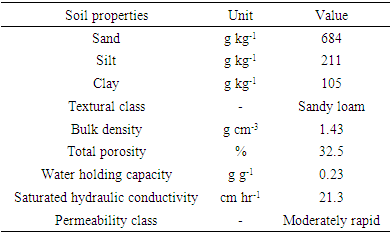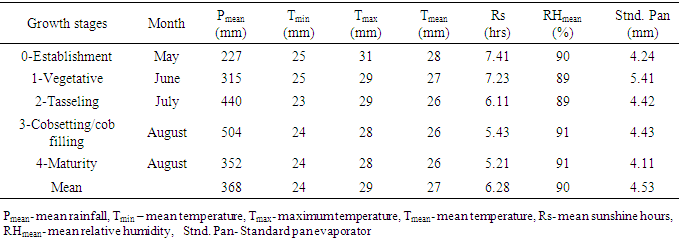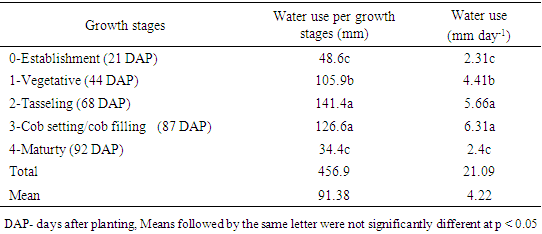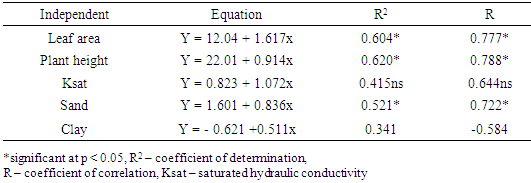| [1] | Agboola, S. O. 2000. An Agricultural Atlas of Nigeria. Oxford University Press, Ibadan, Nigeria. |
| [2] | Akinifesi, F. K., Makumba, W. and Kwesiga, F. R. 2006. Sustainable maize production using Gliricidia/maize intercropping in southern Malawi. Exp. Agric. 42:441-457. |
| [3] | Allen, R. G., Pereira, L. S., Raes, D. and Smith, M. 1998. Crop Evapotranspiration: Guidelines for Computing Crop Water Requirements. FAO Irrigation and Drainage Paper No. 56, FAO, Rome. |
| [4] | Amede, T. and Nigatu, Y. 2001. Interaction of components of sweet potato-maize intercropping under the semi-arid conditions of Rift-Valley, Ethiopia. Tropical Agriculture 78: 1-7. |
| [5] | Barhom, T. I. H. 2012. Studies on water requirements for some crops under different cropping systems. M.Sc. Thesis, faculty of Agriculture, Cairo University. |
| [6] | Blaney, H. F. and Criddle, W. D. 1950. Determining Water Requirements in Irrigated Area from Climatological Irrigation Data. U.S. Department of Agriculture, Soil Conservation Service, Technical Paper No. 96, 48pp. |
| [7] | Bob, S. B. 2015. Irrigation scheduling and evapotranspiration. Santa Clara Valley Water District, Water Use Efficiency Unit, San Jose, CA 95128. |
| [8] | Broner, I. and Schneekloth, J. 2003. Seasonal water needs and opportunities for limited irrigation for Colorado Crops. Newsletter of the Extension Irrigation Services, Department of Civil Engineering, Colorado State University, No: 4, 718. |
| [9] | Dahmardeh, M. A., Ghanbari, B. A., Syahsar and Ramrodi, M 2010. The role intercropping maize (Zea mays L.) and cowpea (Vigna unguiculata L.) on yield and soil chemical properties. African J. Agric. Res. 5: 631-636. |
| [10] | Djaman, K., Mel, V. C., Balde, A. B., Bado, B. V., Diop, L., Manneh, B., Mutiibwa, D., Rudnick, D., Irmak, S. and Futakuchi, K. 2017. Evapotranspiration, irrigation water requirement and water productivity of rice (Oryza sativa L.) in the Sahelian Environment. Paddy and Water Environment 15: 469-482. https://doi.org/10.1007/s10333-016-0564-9. |
| [11] | Djaman, K., O’Neill, M., Owen, C.K., Koudahe, K., West, M., Smeal, D., Allen, S., Lombard, K. and Irmak, S. 2018. Crop evapotranspiration, irrigation water requirement and water productivity of maize from meteorological data under semiarid climate. Water 10: 405. https://doi.org/10.3390/w10040405. |
| [12] | Evett, R. S. 2013. Accuracy and precision of soil water measurements by Neutron capacitant and TDR methods, In: Proceedings of 17th Water Conservation Soil Society Symposium, Thailand, 2002. |
| [13] | FAO (Food and Agricultural Organization), 2013. A Computer Programme for Irrigation Planning and Management, Smith, M. (ed.). Irrigation and Drainage Paper No: 46. Rome. |
| [14] | Flint, L. E. and Flint, A. L. 2002. Pore-size distribution. In: Dane, J. H. and Topp, G. C. (eds.). Methods of Soil Analysis, Part I, Physical Methods, Asa and SSSA, Madison, WI, USA, pp. 246-253. |
| [15] | Gee, G. W. and Bauder, J. W. 1986. Particle size analysis. In: Klute, A. (Ed). Methods of Soil Analysis. Part 1: Agron Monogr. No. 9. 2nd ed. pp. 383-411. |
| [16] | Gicheru, P. Gachene, C., Mbuvi, J. and Mare, E. 2004. Effects of soil management practices and tillage systems on surface soil water conservation and crust formation on sandy loam in semi-arid Kenya. Soil & Tillage Research 75: 173-184. |
| [17] | Gilliam, J. W., Robinson, J. L., Brinsfield, R. B., Staver, K. W., Lucas, W. and Todd, A. H. 1993. Water quality functions of Riparian forest buffers in Chesapeake watersheds. Environ. Manage. 21: 687-712. |
| [18] | Gomez, K. A. and Gomez, A. A. 1984. Statistical Procedures for Agricultural Research. 2nd ed., Wiley Interscience Publication, Singapore. |
| [19] | Grant, R. F., Jackson, B. S. Kiniry, J. R. and Arkin, G. P. 1989. Water deficit timing effects on yield components of maize. Agron. J. 84: 61-65. |
| [20] | Grossman, R. B. and Reinsch, T. G. 2002. Bulk density and linear extensibility. In: Methods of Soil Analysis, Part 4, Physical Methods, Dane, J. H. and Topp, G. C. (eds.). ASA and SSSA, Madison, WI., USA. pp. 201-228. |
| [21] | Hamdy, A., Ragab, R. and Scarascia-Mugnozza, E. 2003. Coping with water scarcity: water saving and increasing water productivity. Irrigation and Drainage 52: 3-20. |
| [22] | Kowal, J. M. and Kassam, A. H. 1973. Water use, energy balance and growth of maize at Samaru, Northern Nigeria. Agricultural. Meteorology 12: 391-408. |
| [23] | Lipiec, J. and Hakansson, J. 2000. Influences of degree of compactness and matric water tension on some important plant growth factors. Soil & Tillage Research 53: 87-94. |
| [24] | McVicar, M., Morgan, K. T., Hanlon, E. A. and Obreza, T. A. 2005. A Web-Based Model to Improve Water Use Efficiecy and Reduce Nutrient Leaching for Florida Citrus SS499. Gainesville, University of Florida, Istitute of Food and Agrcultural Sciences, http://edis.ifas.ufl.edu/pdffiles/ss499. |
| [25] | Michael, J. H. 2009. An improved water-use efficiency for maize grown under regulated deficit irrigation. Field Crop Research 67: 207-214. |
| [26] | Nagesawara, R. L., Simmonds, L. P., Azam-Ali, S. N. and Williams, J. I. 1989. Population, growth, and water use of groundnut maintained on stored water 1: Root and shoot growth. Exp. Agric. 25: 51-61. |
| [27] | Olasantan, F. O. 2008. The effect of soil temperature and moisture content on crop growth and yield of intercropping maize and yam. Exp. Agric. 24: 67-74. |
| [28] | Penman, H. L. 1948. Natural evaporation from open water, bare soil and grass. Procceedings of the Royal Society of London, Series A, Mathematical and Physical Sciences 193: 120-148. |
| [29] | Pruitt, G. 2008. Implementation of FAO-56 Penman-Monteith evapotranspiration in a large scale irrigation scheduling. Water and Environmental Resources Congress, Alaska, USA. |
| [30] | Reichardt, L., Hook, J. E. and Gascho, G. J. 2012. Multiple copping for effeccient use of water and nitrogen. In: Cropping Strategies for Efficient use of Water and Nitrogen. |
| [31] | Hargrove, W. L. (Ed.). America Society of Agronomy, Crop Science Society of America and Soil Science Society of America, Madison, pp. 7-20. |
| [32] | Reynolds, W.D., Elick, D.E., Youngs, E.G., Amoozegar, A. and Bootink, N.W. 2002. Saturated and Field-saturated Water Flow Parameters, In: Dane, J.H., Topp, G.C. (eds.). Methods of Soil Analysis, Part 4. SSSA, Madison, WI, USA, pp. 797–878. |
| [33] | SAS–Statistical Analysis System. 2001. Institute SAS/STAT User’s Guide, 4th ed., Vol. 1.SAS Inst. Cary, NC, USA. |
| [34] | Shih, S. F. and Gascho, G. J. 1990. Relationship among stalk length, leaf area and dry biomass of sugarcane. Agron. J. 72: 309-313. |
| [35] | Smith, J. A., Lal, R. and Russel, E. W. 2005. Soil conditions and plant growth, 12th Edition. |
| [36] | Smith, M., Ruben, J. and Kivumbi, D. 2002. Use of FAO CROPWAT model in deficit irrigation studies. FAO Water Reports 22: 17-28. |
| [37] | Soil Survey Staff 1993. Soil Survey Manual. USDA, Soil Conservation Service, Agricultural Handbook No. 18, Print Office, Washington, DC, USA. |
| [38] | Udom, B. E. and Kamalu, O. J. 2016. Sealing index, air-filled porosity and hydrological behaviour of a Tropical ultisol as affected by incidental flooding and soil disturbance. Int. J. Soil Sci. 11: 79-86. |
| [39] | USDA–U. S. Department of Agriculture. 2012. Soil Survey Manual (Revised). USDA, Print Office, Washington, DC, USA. |
| [40] | Varga, B., Varga-Laszlo, E., Bencze, S., Balla, K. and Veisz, O. (2013) Water Use of Winter Cereals under Well-Watered and Drought Stressed Conditions. Plant, Soil and Environment, 59, 150-155. https://doi.org/10.17221/658/2012-PSE. |
| [41] | Wright, G. C. and Bell, M. F. 1992. Plant population studies on groundnut (Arachis hypogaea L.) in subtropical Australia 3: Growth and water use during a terminal draught stress. Aust. J. Exp. Agric. 32: 197-203. |














 Abstract
Abstract Reference
Reference Full-Text PDF
Full-Text PDF Full-text HTML
Full-text HTML




